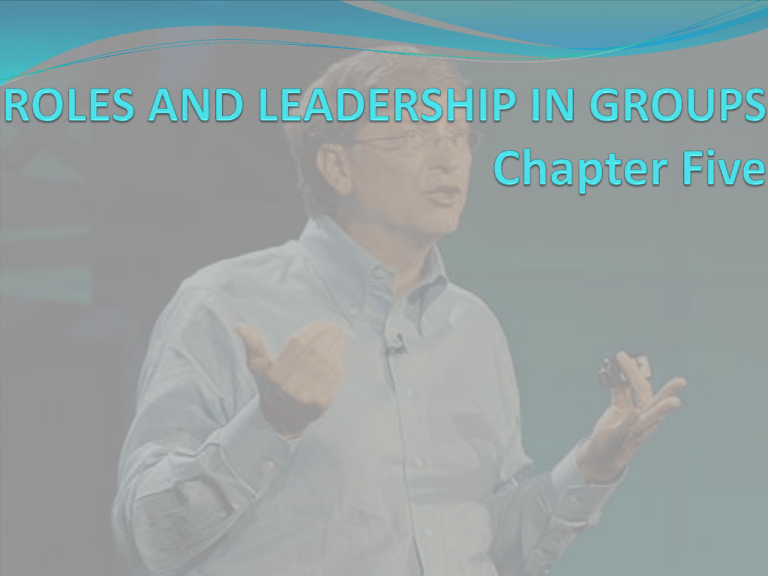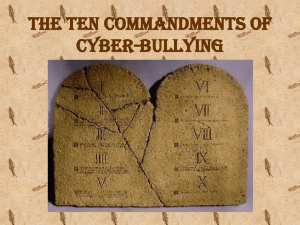Chapter 5 - People Server at UNCW
advertisement

GROUP ROLES What are Norms? Norms are broad rules that designate appropriate behavior for all group members while roles stipulate behaviors that are expected for individuals group members. ROLE REVERSAL: WHEN STUDENTS BECOME TEACHERS What is role reversal? Role Reversal is stepping into a role distinctly different from or opposite of a role we usually play. What is role conflict? We experience role conflict when we are playing roles that contradict each other. TYPES OF ROLES: FORMAL AND INFORMAL In the broadest sense, roles are categorized as formal and informal. A formal role is a position assigned by an organization or specifically designated by the group leader. Some examples are: President, Chair, Secretary, etc. In smaller groups, the roles are mostly informal. An informal role emerges from the group transactions, and it emphasizes functions, not positions. An example would be when a member fulfills a leadership function without any formal designation. TYPES OF ROLES Continued What does a Task Role do? Task roles move the group toward the attainment of its goals. The central communication function of task roles is to extract the maximum productivity from the group. (See page 146 in text) What do Maintenance Roles focus on? Maintenance roles focus on the social dimension of the group. The central communication function of maintenance roles is to gain and maintain the cohesiveness of the group. (See page 146-147 in text) What do Disruptive Roles do? Self-centered or disruptive roles serve individual needs or goals (Me-oriented) while impeding attainment of group goals. This is a difficult group member. Their function is to focus attention on the individual. (See page 147 in text) LEADERSHIP 1. Why do people want to be leaders? 2. How is the process for retaining the leader role different from the process for emerging as group leader? 3. Are women and ethnic minorities equally capable leaders as white males? DEFINITION OF LEADERSHIP: AN EVOLVING CONSENSUS What is the evolving consensus on what leadership is and is not? Leadership is a social influence process This influence can come from status, authority, personality, interpersonal and group communication skills, and many other factors. Creditability is the foundation for successful influence (the ancient Greeks called it ethos) Leaders influence follows but followers also influence leaders The leader and follower roles exist together, or not at all LEADER VERSUS MANAGER: INTERPERSONAL VERSUS POSITIONAL INFLUENCE What is the difference between a leader and a manager? A leader does not operate from a positional authority; a manager does. Anyone in a group can exhibit leadership without being designated the leader. Managers maintain the status quo, leaders work to change the status quo. Leadership implies change. Leaders inspire and motivate. They are transformational. LEADER VERSUS MANAGER Continued What does charismatic mean when applied to leadership? Charismatic means exhibiting a constellation of personal attributes that group members find highly attractive and strongly influential. When managers change, motivate and inspire followers while creating direction for the group, the manager is acting as a leader, not a manger. LEADERSHIP AND COMMUNICATION Leadership is fundamentally a communication process. Great leadership is the product of great communication. Effective communication is a precondition for a highquality leader-follower relationship to develop. The leader sets the emotional tone for the group. GAINING AND RETAINING LEADERSHIP: GETTING THERE IS JUST THE START A competent communicator who wishes to emerge as group leader should heed the following observations: Thou shalt not show up late for or miss important meetings. 2. Thou shalt not be uninformed about a problem commanding the group’s attention. 3. Thou shalt not manifest apathy and lack of interest by sluggish participation in group discussions. 4. Thou shalt not attempt to dominate conversation during discussion. 1. GAINING AND RETAINING LEADERSHIP Continued 5. Thou shalt not listen poorly. 6. Thou shalt not be rigid and inflexible when expressing viewpoints. 7. Thou shalt not bully group members. 8. Thou shalt not use offensive and abusive language. RETAINING THE LEADER ROLE: HANGING ONTO THE POWER There are three primary qualifications for retaining leadership: You must demonstrate your competence as leader. 2. You must accept accountability for your actions. 3. You must satisfy group members’ expectations. 1. PERSPECTIVES ON EFFECTIVE LEADERSHIP: AN EVOLVING VIEW What is the Traits Perspective or the Born Leader View about? Early studies on leadership set out to discover a universal set of traits applicable to all those who become leaders. What was the result of the Traits study? Traits such as intelligence, social and verbal skills, integrity, sense of humor, or confidence may be necessary yet not sufficient for an individual to be an effective group leader. Leadership is a process not a person. STYLES PERSPECTIVE: ONE STYLE DOESN’T FIT ALL Kurt Lewin developed a new approach on which three leadership styles? Autocratic Style or Directive Style 2. Participative Style or Democratic Style 3. Laissez-faire Style 1. Note: A combination of participative and directive leadership styles is Required in small groups. STYLES PERSPECTIVE CONTINUED What is Situational Leadership all about? No one style of leadership is appropriate for all situations. It is contingent upon matching styles with situations. Hersey and Blanchard have developed a model of leadership effectiveness. They have combined three variables in their model. SITUATIONAL LEADERSHIP MODEL The three variables in the situational leadership model are: The amount of guidance and direction (task emphasis) a leader provides. 2. The amount of relationship support (socio-emotional emphasis) a leader provides. 3. The readiness level in performing a specific task, function, or objective that followers demonstrate. 1. FOUR LEADERSHIP STYLES IN THE MODEL What are the four leadership styles in the Hersey and Blanchard model? 1. 2. 3. 4. The Telling Style The Selling Style The Participating Style The Delegating Style Note: The key to leadership effectiveness is matching the appropriate style to the group environment. Find out what the readiness level is to perform a task. “Dave” VIDEO CASE STUDY “Erin Brockovich” VIDEO CASE STUDY “The Great Santini” VIDEO CASE STUDY “Abandon Ship” VIDEO CASE STUDY “Abandon Ship” VIDEO CASE STUDY Twelve Angry Men #6 #4 #2 #10 #12 #3 #11 #1 #8 #9 #7 #5








